
NI 9683 User Guide and Specifications
|
© National Instruments
|
9
Figure 11.
Connecting a Current Sensor to the NI 9683
To avoid the affect of common mode impedance on the measurement, connect one end of all the
termination resistors to a single, small plane. Then have a single connection from the plane to
the CS COM pin of the NI 9683.
The NI 9683 simultaneous analog inputs have ±10 V and ±5 V input ranges that can
accommodate termination resistor values in a certain range, based on the sensor peak current.
Select the highest possible termination resistor to maximize the dynamic range of the analog
input. Refer to the
section for more information about the analog input range. Use
the following equation to determine the maximum value for the terminal resistor based on the
sensor peak current.
For a current sensor with a peak output current of 70 mA, the maximum termination resistor that
can be used with the NI 9683 is as follows:
Note
Using the ±5 V input range can reduce the power dissipation on the
termination resistor by 50% when compared to the power dissipation of the ±10 V
input range.
Scanned Analog Input (Monitoring)
The NI 9683 provides connections for 8 single-ended scanned analog input channels.
Each channel has an AI pin to which you can connect a voltage signal. Scanned analog input and
scanned analog output channels share four GND pins on the dedicated 20-position connector.
NI 96
83
Interf
a
ce Bo
a
rd
Termin
a
tion
Re
s
i
s
tor
AI0+
OUT
P
S
–
P
S
+
P
S
–
P
S
+
AI1+
C
S
COM
COM
I
s
ol
a
ted
ADC
C
u
rrent
S
en
s
or
Extern
a
l
Power
Su
pply
R
max
5
V
I
_
peak
max
--------------------------
=
R
max
5
V
0.07
A
--------------
71
Ω
=
=









































